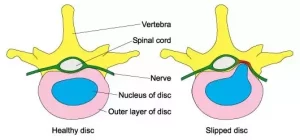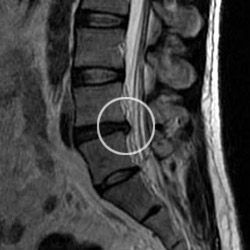What is a prolapsed (‘slipped’) disc?
A ‘slipped disc’ occurs when the gel-like centre of one of the cushions between the vertebrae (building locks of spine) escapes from its outer casing. A fragment may cause pressure on one or more of the nerves which supplies the legs causing leg pain (‘sciatica’). As with most low back problems, the vast majority will rectify themselves with time.
 Prolapsed disc
Prolapsed disc

Spinal MRI: Prolapsed disc touching spinal nerves (not everyone needs an MRI)
In fact, 90% are better by six weeks. Those cases of sciatica which do not resolve with time and exercises, may benefit from an ‘epidural’ injection of anaesthetic and steroid medication. This can be a useful test both to confirm the cause of pain, and to provide long enough symptomatic relief for the problem to rectify itself.
Surgery to decompress the nerves may be offered when conservative treatment (rest, injections etc) has failed. Normally this can be done through a small cut in the lower back but it does carry some risk. Rarely, metal implants may be recommended if there is an underlying instability of the spine.

